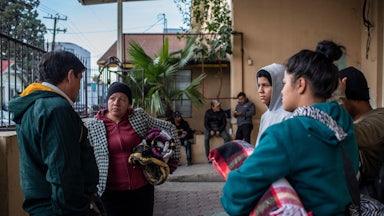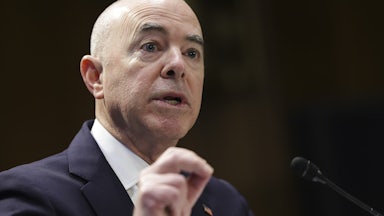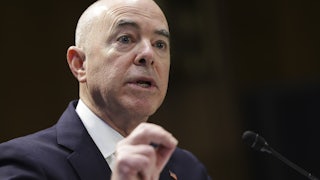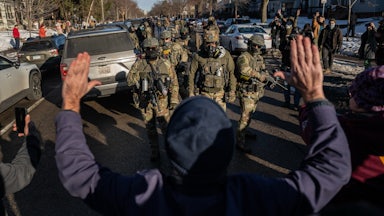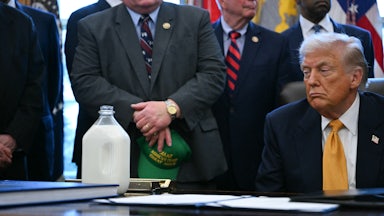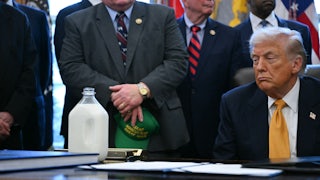Earlier this year, a federal judge in Texas effectively commandeered federal immigration enforcement at the behest of a coalition of Republican-led states. The Supreme Court heard oral arguments on Tuesday on whether it can do that and what should happen next. The case can be understood within the context of immigration law, federalism, and the separation of powers. But it can also be understood as a series of riddles that the justices must answer in turn.
If reading about a case titled United States v. Texas gives you a strong sense of déjà vu, there are good reasons. Texas and other GOP-led states routinely sue the Biden administration to block new federal policies from going into effect, ranging from abortion access to Covid-19 masks on airplanes to other border-related matters. While Democrats adopted similar tactics during the Trump years, Republicans have an edge thanks to the way the federal courts are currently structured in some parts of the country.
“In Texas, there are divisions within [federal court] districts,” Justice Elena Kagan told Texas Solicitor General Judd Stone at one point during oral arguments. “You can pick your trial court judge. You know, you play by the rules, that’s fine, but you pick your trial court judge. One judge stops a federal immigration policy in its tracks because you have a sort of speculative argument that your budget is going to be affected.”
This practice has allowed Republican-led states to ensure that their case would be heard by sympathetic judges—in this case, Judge Drew Tipton, who was nominated by Donald Trump to a federal district judgeship in Texas in 2020. Earlier this year, Republican attorneys general in Texas and Louisiana sued the Department of Homeland Security to block its new set of immigration-enforcement priorities, arguing that they violated federal immigration law. Tipton agreed and vacated the DHS priorities.
Kagan’s budget remark is a reference to the first riddle, which is whether Texas and the other states have standing to challenge the enforcement priorities at all. The states insist they have standing because DHS’s enforcement decisions could require them to spend more on health care and education costs in their respective state budgets. Similar arguments have allowed states to challenge a variety of federal policies in recent years.
In practical terms, however, letting states effectively decide federal immigration policy through litigation sat uneasily with some of the justices. “There’s an issue here, especially with respect to immigration policy,” Kagan told Stone. “Immigration policy is supposed to be the zenith of federal power, and it’s supposed to be the zenith of executive power. And instead, we’re creating a system where a combination of states and courts can bring immigration policy to a dead halt.”
Roberts questioned Solicitor General Elizabeth Prelogar, who argued on behalf of the Justice Department, whether her reading of one of the court’s precedents would make it impossible for states to sue the federal government over detention and removal decisions in immigration cases. “That’s right,” she replied. “We think that the court articulated a principle there that an individual or a state doesn’t have a judicially cognizable injury in seeking enforcement of the law against a third party.” Roberts suggested that this approach was at odds with how the Justice Department has previously handled state standing in other recent cases, including one decided last term.
If the court decides that the states don’t have standing, then the case ends there with a victory for the government. Otherwise, we move to the second riddle, which concerns the statutory text. The Republican-led states argued that certain provisions of federal immigration law that say that the executive branch “shall” take into custody and remove certain undocumented persons should be interpreted literally and that the Biden administration’s efforts to prioritize those with more serious criminal histories over others is illegal.
The Justice Department, for its part, countered that this reading would be unfeasible and unreasonable under the current circumstances. “This court has repeatedly held that the word ‘shall’ does not displace background principles of enforcement discretion,” Prelogar argued. “Across 25 years and five presidential administrations, the agency has never implemented the [Immigration and Nationality Act] in the manner that [Texas and the other states] suggest. Given congressional funding choices, it would be impossible for DHS to do so.”
That may be a hard sell among the court’s conservative justices, however. “Now it’s our job to say what the law is, not whether or not it can be possibly implemented or whether there are difficulties there,” Roberts told Prelogar while speaking hypothetically. “And I don’t think we should change that responsibility just because Congress and the executive can’t agree on something that’s possible to address this problem. I don’t think we should let them off the hook. So shouldn’t we just say what we think the law is, even if we think ‘shall’ means ‘shall,’ and then leave it for them to sort that out?”
Should the justices agree with the states on “shall,” then they will come face to face with the third, final, and perhaps most intriguing riddle: whether Tipton could actually vacate the rule itself. The Justice Department argued that federal immigration law only gives him and other federal judges the power to “set aside” a rule like the enforcement priorities in specific cases. “You do not vacate or void the statute and take it off the statute books,” Prelogar explained to the justices. “Instead, you literally disregard it for purposes of fixing the rights of the parties before you. And we think that’s how Section 706 uses the term.” That position would give the executive branch more power over immigration rules by sharply limiting the lower federal courts’ power to curb them.
This argument drew intense questioning from justices who had previously served on the D.C. Circuit Court of Appeals, which hears a disproportionate number of cases involving federal agencies and regulations. “Your position on vacatur, that sounded to me to be fairly radical and inconsistent with those of us who were on the D.C. Circuit,” Roberts, who served on that court from 2003 to 2005, told Prelogar. “Five times before breakfast, that’s what you do in an APA case. And all of a sudden you’re telling us that, no, you can’t vacate it, you do something different.”
Kavanaugh, who served on the D.C. Circuit from 2006 to 2018, sharply criticized the government for raising it. “The government never has made this argument in all the years of the APA, at least not that I remember sitting there for 12 years,” he claimed. “I haven’t seen it made. It’s a pretty radical rewrite, as the chief justice says, of what’s been standard administrative law practice.” Jackson, the court’s newest former D.C. Circuit judge, also said that she had “concerns” about the department’s view on vacatur.
Other justices seemed more open to this reading of federal immigration law on textualist grounds. Gorsuch, who served on the Tenth Circuit before joining the high court, appeared sympathetic to the administration’s reading of the law. “Some of us didn’t have the benefit of sitting on the D.C. Circuit five times before breakfast entering these orders,” he told Prelogar, to laughter in the courtroom. “And, you know, I stare at the language and I hear your argument.” Barrett and Kagan also hinted that they might be open to the department’s view, with Kagan quipping, after Jackson joined Roberts and Kavanaugh in questioning it, that there “seems to be a kind of D.C. Circuit cartel.”
The answers to these riddles were no less enigmatic after oral arguments than at the start. Answering them in certain ways could have broad implications for other cases where states sue the federal government, for how immigration law is enforced by the executive branch, and for how federal courts hear challenges to federal immigration policies. A splintered decision where the conservative justices side with the states on the first two questions and then fracture on the remedy appears possible, if not probable. But the real answer won’t be known until the court issues a decision sometime in the first half of next year.

